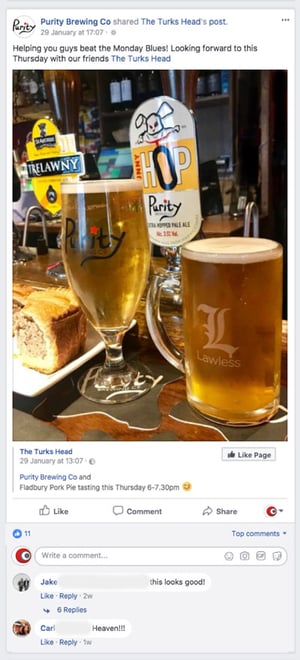Welcome back to our Sell More Beer 101 blog. So far, we have established that to stand out from the crowd, you need an excellent beer and outstanding knowledge of your product and we’ve discussed how to build the foundations of a winning brand. Feel free to read 'Sell More Beer 101 Part 1' before you continue with this one.
Here’s the next instalment of our ‘to-do list’ to make your tipple top of the pile
4. Be Social
Don’t rely on the bars and restaurants to sing your praises on all of the various social media streams available just because you sell to them. They will be busy enough with special events, promotions and fighting for business with their competitors. But shouting into the void of the internet about how awesome your beer is won’t do that much either… so what should you do?
Just be, well, social. You can do this by:
- Connecting with your customers on various platforms
- Engage with end users (your drinkers), run competitions, offer food pairing advice and chat about your shared love of all things beer
- Supporting their promotions that relate to your products
- Supporting their events and venue-specific celebrations/promotions to show that you care about their success (whilst keeping your product at the front of their mind).
- Mention customers in your posts when they take on a new product, hit a milestone as a customer or when you meet with them. Everyone likes a pat on the back.
- Go live online and share behind-the-scenes moments at the brewery, such as taste tests, information about the people that make your beer and special moments that make your brand resonate with your audience rather than just a faceless product.
- Focus on being loyal and local.
- Associate yourself with popular trends at the time.

A post from Purity’s Facebook page.
It has never been easier to get your beer in front of millions of people, but this comes with the added complication that a lot of other beers are already working the system. To be heard in the noise, you need to have something special that will catch the attention of your target audience.
For many independent businesses, this can be their connection to their local community. Testing your messaging out on a focused target audience is essential. This is something you should have an idea of from when you created your brand and who you are selling your beer to currently.
You can do this in various ways through each social channel. Here are a couple of examples to get you started:
Twitter Hashtags.
Find the hashtags that your audiences are using and following. At a basic level, you should add your local area, product name and slogans.
You can see this in action with sales-i customer Beavertown Brewery’s Twitter account. They make sure to #Beavertown posts and separate out their unique antics with #teambeaver
Facebook.
As a more relaxed platform with unlimited characters, you can extend your posts to include links to partners and promote your products.
With a focus on local, Facebook is great for hitching your wagon to local events.
5. Lead the charge
Who are your top advocates? If it isn’t you and your employees, why not? You have missed an essential step in developing your brand, as good PR begins at home.
- Key to getting all your staff on board is education. Make sure all your staff know what you do, why you do it and what your brand is all about.
- Use this valuable resource to spread the word about your products and your brand across social networks and word of mouth.
- How people interact with your social posts accounts for a significant proportion of your Google Adwords relevancy score. So, encouraging your staff to interact with your posts is a great boost to your marketing campaign.
- Be willing to help your buyers to correctly position your products to increase sales.
- Have competitions relating to your product for end users. Make sure to mention where people can sip on your tasty beer local to them.
- Keep up-to-date with industry news, participate in events and join the conversation online with fellow breweries to increase your social influence and industry standing.
Each of these will ensure that you spread your social influence through each of your customers and competitors’ audiences as well as your own..



